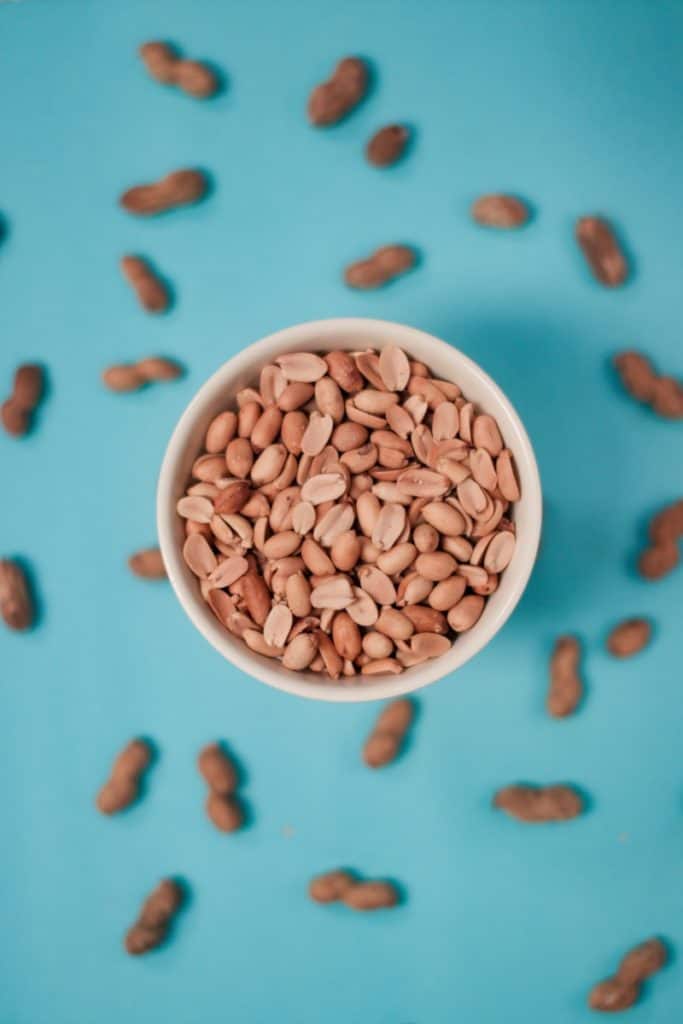This post may contain affiliate links. If you click one and make a purchase, I earn a small commission at no extra cost to you. It helps support the site so I can continue to offer great content to you!

If you or someone in your family has recently been diagnosed with food allergies, it can be extremely stressful. You might feel that your food options have diminished and that you will need to make multiple dishes every meal. I’m happy to tell you it does not have to be that way. In this article, I will share information and tips to help you learn to cook around common food allergies.
What do I know about common food allergies?
First thing first, what qualifies me to talk about this you might ask? Let me share a little of my journey.
- My son was diagnosed with food allergies at 6 weeks old! You read this correctly. He was so sick and his eczema so severe that they tested him for 7 of the most common allergens at 6 weeks old. He was positive (allergic) to milk, soy, and eggs.
- We were instructed to stay away from peanuts and tree nuts until he would get tested again, more extensively before kindergarten.
- In the meantime, my daughter was born and was allergic to dairy for the first year of her life. We were also instructed to keep her away from peanuts and tree nuts at the time.
- My son received additional testing before starting kindergarten. He was still allergic to eggs and also tested positive for peanuts and several tree nuts!
- A few years later my daughter was tested and was also positive for peanuts and several tree nuts!
- Meanwhile, I had always had digestive problems. In 2020, I finally decided to get tested for allergies myself and learned that I was allergic to the following food:
- legumes
- soy
- peanuts
- several tree nuts
- peas
- fennel
- I also digest dairy poorly although I am not allergic
Therefore, I believe I have quite a bit of experience dealing with food allergies for now 15 years. I have learned a ton over the years and I hope to share some tips with you to make your life easier.
Common food allergies
Eggs
Eggs are found in many food items. Depending on your sensitivity to eggs it can make it quite stressful to eat out. However, the good news is that many restaurants have allergens menus. When they do, eggs are always listed. You can also ask the restaurant’s staff to confirm whether or not a recipe contains eggs. Here are some food items to be careful with:
- Mayo
- Complete pancake mix (where you only add water)
- Other cake mixes
- Eggs noodles but also regular noodles can contain eggs
- Alfredo sauce
- Fish sticks/chicken nuggets etc are often dipped in eggs
- Dips and sauces

When you plan to eat out, I recommend looking at the menu before you go out. If they do not provide an allergen menu online, you can contact the restaurant in advance to inquire about allergens. Lastly, always bring a few snacks with you just in case.
When cooking at home, you can replace eggs in many different ways. In baked goods, one of my favorite ways is to use applesauce instead of eggs. Another option is to buy an egg replacer. There are many on the market, just make sure it doesn’t contain other allergens you are trying to avoid.
Pro tip: when making “no eggs” baked goods, consider making extra that you can freeze. This was helpful when my son was little. I was able to grab a few cupcakes when going to a birthday party or warm-up pancakes that he could have in the morning without making a full batch.
Milk (dairy)
Dairy is another extremely common food allergen, especially in young children. Replacing the milk that you drink is somewhat easy but replacing all dairy when you cook is more complicated. Dairy tends to be a little easier to spot in restaurant dishes. It is also easier to get a straight answer from most restaurant staff on whether or not a meal contains dairy. A few watch out foods for dairy are:
- Pesto (usually made with parmesan cheese)
- Cream sauce
- Breading (fish sticks, chicken nuggets etc.) and croutons
- Steak!! Many restaurants put butter on top. Make sure to ask for a plain steak. (butter is often added to seafood as well)
- Soups
- Bread & crackers
- Chocolate
- energy bars
- Desert
When cooking at home, there are tons of different milk you can choose from instead of cow milk. You can easily replace butter with non-dairy alternatives or olive/avocado/coconut oil. One of the trickiest for me is finding a good cheese replacement. If you have no other common food allergies, there are actually quite a few options out there. Before learning about my own food allergies, some of my favorites were Daiya and Miyokos. My soy-free, dairy-free and nut-free favorite is Violife.
Pro tip: when trying to replace cream in a recipe, use coconut cream. The texture will be the same as if you used regular cream and you won’t have to make a separate recipe or exclude all yummy creamy types of dishes from your diet. You do need to like the taste of coconut but I successfully switched the entire family to coconut cream and I never hear a complaint.
Pro tip 2: non-dairy cheese does have a different texture. What I do is serve the dairy-free person first and add the non-dairy cheese only to that serving and use regular cheese for the other people.
Soy
This one is probably one of the most difficult allergens to deal with, especially when eating out. Soy is hidden in so many foods! I do the best I can but I often “fail” and realize something had soy in it after I had it. Thankfully, my allergy is not the anaphylaxis type but it is still highly unpleasant when it happens. Here are some foods to watch out for if you are trying to avoid soy:
- Soy sauce (tricky in the sense that it is used in many sauces, dressings, soups, marinade etc)
- Worcestershire sauce
- Edamame & tofu (some don’t realize they are soy)
- Bread, crackers, cookies, desserts
- Many non-dairy and vegan items
- Pasta
- Broth
- Some extra allergic people may react from meat where the animal was fed soy
As you can see, soy is a pain to have as an allergy but you can learn to live with it. Again, talk to the restaurant staff and take as many precautions as you can. When cooking at home, here are my favorite substitutes:
- Coconut amino instead of soy sauce
- Soy-free Teriyaki, sauces, and marinade by Primal Kitchen
Wheat
This is one food allergy we have not had to deal with. However, I did have to follow an elimination diet because of IBS problems in 2020. It is important to understand that wheat and gluten are NOT the same things. Gluten is the protein found in wheat, barley, and other grains. Not every food containing gluten contains wheat. The allergy to gluten is commonly known as celiac disease and is a serious condition. This section is not focused on gluten but rather wheat itself.
Some foods are easy to identify as containing wheat such as bread, pasta, or baked goods made of regular wheat flour. Here are a few meals/foods to watch out for that can contain wheat:
- Soups and sauces (flour is often used as a thickening agent)
- Beer
- Some chicken and beef broth
- Granola bars
- Some salad dressings
Because of the rise in celiac diseases diagnosis, there are a lot of products that are gluten-free and often wheat-free these days. As with all other allergens, read the labels and ask questions to the restaurant staff when in doubt.
Pro tip: At home, you can easily replace traditional wheat flour with flours that do not contain other allergens you need to stay away from. If tree nuts are not a problem for you, almond flour is a common substitute for wheat flour. Other good substitutes are oat or rice flour. But, always read the labels to confirm the allergen is not present.
Peanuts and tree nuts
For the sake of this article, I will combine the two. However, it is important to know that they are separate allergens. People with a peanut allergy might not be allergic to tree nuts and vice versa. Furthermore, people with a tree nut allergy are not necessarily allergic to all tree nuts. Lastly, peanuts are a legume. Some people with peanuts allergies also react to legumes such as lentils, peas, or black beans.
As for the other common food allergies listed in this article, peanuts and tree nuts’ presence or manufacturing risks are well-identified on all food labels in the United States. It was once easier to determine that peanuts or tree nuts were present in a food. With the rise of celiac disease cases and the adoption of new food diets such as the keto diet, it has become slightly more difficult to know if a food contains peanuts or tree nuts without reading the label. For example, many have started to use almond flour in baked goods, crackers etc.
Here are some watch out foods that may contain peanuts or tree nuts:

- Pesto (traditional pesto is made with pine nuts)
- Soups and pasta sauces (sometimes thickened with peanut paste or can contain pesto)
- Baked goods, crackers, bread, pie crust or pasta
- Ice cream
- Energy bars
- International food (Thai and Indian food especially)
- Sauces and dressings
Pro tip: Make your pesto at home using seeds such as sunflower or pumpkin seeds. If dairy is also an issue, you can use nutritional yeast as a substitute. You’ll be surprised how good this is.
Pro tip 2: Use sunflower seeds butter or sesame butter (tahini) in Thai, Indian dishes, and baked goods to replace peanut or tree nut butter.
Note: Sesame is on the rise as the 9th common allergen and is going to be reported on food labels starting in January of 2023.
In conclusion..
It is possible to eat safely and enjoy a wide variety of food even if you suffer from one or multiple food allergies. Always read the labels when you can, do not hesitate to ask questions to the restaurant’s staff or the host where you are, and always carry an EpiPen if one has been prescribed to you by your healthcare provider.
I hope this article was helpful if you or someone in your family was recently diagnosed with one or more of the common food allergies.
Thank you for reading and please share if you think the information in this article would be helpful to others.
Cat xx